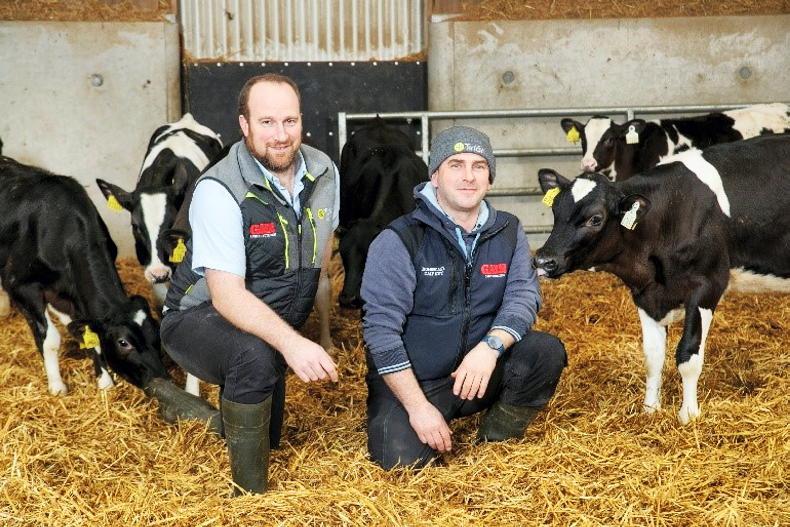John Wynne and his mother Frances run Manger Farm, a dairy and tillage farm in Stratford-on-Slaney, Baltinglass, Co Wicklow.
They milk 300 cows and manage 170 acres of tillage, a sustainable rotation of maize, wheat, oats and barley to feed the predominantly Holstein Friesian herd.
“My mother is still very active on the farm,” John said. “She’s farmed here with my late father all of her life and is an incredible sounding board on so many of the critically important decisions that are made on farm.
“We calve twice a year, typically drying off 60 days before calving, 70 days for twins. The herd then goes on a high-fibre controlled energy diet which includes feeding dry cow minerals.
“The herd has an EBI of €219, milk €64, fertility €104 and a maintenance value of €10. Typical milk solids (MS) sold are 570 to 580MS/cow. Everything starts with the cow and its condition score.
"Every cow is vaccinated and dosed three to four weeks out from calving, they get their tails clipped and we segregate them into groups, based on their calving dates.
Calving preparation
“We pre-scan and post-scan all of our cows. Ahead of calving in autumn and spring, all the calving areas are pressure-washed and disinfected three weeks out.
"Our autumn calving takes place in October/November and spring calving runs across February and March, into early April. We’ve already begun calving with a handful of cows this season. Because we used sexed semen and the dry cow diet the herd follows, we have very few assisted births.
“As soon as a calf is born, it is taken to a warm single pen and gets approximately three litres of colostrum through a stomach tube and its naval is treated.
"After 12 hours, jackets are introduced to help conserve heat. After three days, they are built up to four litres twice a day. The calves get colostrum twice a day for seven days."

The Wynnes say it has taken a while to achieve the level of sustainability and efficiency they now enjoy and put much of it down to GAIN Easi-Mix Calf Milk Replacer, as it provides a complete solution to the family farm.
Feeding the growing calf
John says GAIN Easi-Mix Calf Milk Replacer best suits the calf-rearing system they’ve developed on the family farm. The consistency of its composition and suitability for their automatic feeding system is key to producing a healthy calf.
“We then move on to GAIN Easi-Mix Calf Milk Replacer, which is administered through an automated calf feeder for 40 days ad lib. This gives them the best possible opportunity to grow their animal structure and body muscle. Feeding ad lib allows them to best develop, specific to the need of each individual calf. This is followed by 30 days of weaning.
“It's our second year in the new calf shed and we tweaked the feeder so we have had zero trouble with the calves. With GAIN Easi-Mix Calf Milk Replacer, they get that consistency in their feed every single time.
“Feeding the milk replacer through the automatic feeder using a specific teat to create a sucking motion also ensures saliva is created. This saliva generates the right environment for them to be able to digest and absorb the nutrients they need to thrive.”
John’s business manager Seán Jackson provides any advice sought and additional technical back-up or farm management support that is required throughout the year.
"GAIN Easi-Mix Calf Milk Replacer has reduced the number of problems and increased intake to aid growth and muscle development in our calves. Using it ensures biosecurity and the reduced risk of transmission of infection such as Johnes disease.
“Consistency of composition is key when compared to transition milk mixed from cows in different stages after calving that can sometimes be associated with contributing to nutritional upsets. Calving is already a very busy time and using GAIN Easi-Mix Calf Milk Replacer saves on labour, especially when feeding is automated.
“Using GAIN Easi-Mix has gotten us to a place where the problems just aren’t there. The feeder is set up and we’re ready for calving.”
GAIN Easi-Mix calf milk replacer is a 25% protein premium milk replacer for home-reared replacement dairy heifers and general use. It promotes trouble-free performance within young calves. The product is formulated to support optimal calf growth and development. It contains a carefully balanced blend of highly digestible refined milk products to ensure excellent performance.
For more information on the GAIN Animal Nutrition Calf Milk Replacer range, please contact your local Tirlán FarmLife business manager, branch or visit tirlanfarmlife.com.
John Wynne and his mother Frances run Manger Farm, a dairy and tillage farm in Stratford-on-Slaney, Baltinglass, Co Wicklow.
They milk 300 cows and manage 170 acres of tillage, a sustainable rotation of maize, wheat, oats and barley to feed the predominantly Holstein Friesian herd.
“My mother is still very active on the farm,” John said. “She’s farmed here with my late father all of her life and is an incredible sounding board on so many of the critically important decisions that are made on farm.
“We calve twice a year, typically drying off 60 days before calving, 70 days for twins. The herd then goes on a high-fibre controlled energy diet which includes feeding dry cow minerals.
“The herd has an EBI of €219, milk €64, fertility €104 and a maintenance value of €10. Typical milk solids (MS) sold are 570 to 580MS/cow. Everything starts with the cow and its condition score.
"Every cow is vaccinated and dosed three to four weeks out from calving, they get their tails clipped and we segregate them into groups, based on their calving dates.
Calving preparation
“We pre-scan and post-scan all of our cows. Ahead of calving in autumn and spring, all the calving areas are pressure-washed and disinfected three weeks out.
"Our autumn calving takes place in October/November and spring calving runs across February and March, into early April. We’ve already begun calving with a handful of cows this season. Because we used sexed semen and the dry cow diet the herd follows, we have very few assisted births.
“As soon as a calf is born, it is taken to a warm single pen and gets approximately three litres of colostrum through a stomach tube and its naval is treated.
"After 12 hours, jackets are introduced to help conserve heat. After three days, they are built up to four litres twice a day. The calves get colostrum twice a day for seven days."

The Wynnes say it has taken a while to achieve the level of sustainability and efficiency they now enjoy and put much of it down to GAIN Easi-Mix Calf Milk Replacer, as it provides a complete solution to the family farm.
Feeding the growing calf
John says GAIN Easi-Mix Calf Milk Replacer best suits the calf-rearing system they’ve developed on the family farm. The consistency of its composition and suitability for their automatic feeding system is key to producing a healthy calf.
“We then move on to GAIN Easi-Mix Calf Milk Replacer, which is administered through an automated calf feeder for 40 days ad lib. This gives them the best possible opportunity to grow their animal structure and body muscle. Feeding ad lib allows them to best develop, specific to the need of each individual calf. This is followed by 30 days of weaning.
“It's our second year in the new calf shed and we tweaked the feeder so we have had zero trouble with the calves. With GAIN Easi-Mix Calf Milk Replacer, they get that consistency in their feed every single time.
“Feeding the milk replacer through the automatic feeder using a specific teat to create a sucking motion also ensures saliva is created. This saliva generates the right environment for them to be able to digest and absorb the nutrients they need to thrive.”
John’s business manager Seán Jackson provides any advice sought and additional technical back-up or farm management support that is required throughout the year.
"GAIN Easi-Mix Calf Milk Replacer has reduced the number of problems and increased intake to aid growth and muscle development in our calves. Using it ensures biosecurity and the reduced risk of transmission of infection such as Johnes disease.
“Consistency of composition is key when compared to transition milk mixed from cows in different stages after calving that can sometimes be associated with contributing to nutritional upsets. Calving is already a very busy time and using GAIN Easi-Mix Calf Milk Replacer saves on labour, especially when feeding is automated.
“Using GAIN Easi-Mix has gotten us to a place where the problems just aren’t there. The feeder is set up and we’re ready for calving.”
GAIN Easi-Mix calf milk replacer is a 25% protein premium milk replacer for home-reared replacement dairy heifers and general use. It promotes trouble-free performance within young calves. The product is formulated to support optimal calf growth and development. It contains a carefully balanced blend of highly digestible refined milk products to ensure excellent performance.
For more information on the GAIN Animal Nutrition Calf Milk Replacer range, please contact your local Tirlán FarmLife business manager, branch or visit tirlanfarmlife.com.








 This is a subscriber-only article
This is a subscriber-only article




